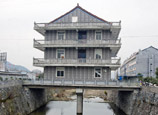
The slowdown in the growth of China’s industrial sector, which has reached a certain scale, is in line with natural economic laws. The country has moderately lowered its industrial growth target, and paid more attention to improving the quality and efficiency of industrial growth as well as promoting industrial restructuring, transformation and upgrading.
China’s industrial sector experienced three phrases last year.
The first phrase is “great impact.” The global financial crisis hit China’s industrial sector harder than expected. Last year, the annual growth rate of the country’s exports dropped 12.4 percentage points to 8 percent, and the growth rate of its exports of industrial products dropped 9.5 percentage points to 7 percent.
The second phrase is “heavy pressure.” China was under a heavier-than-expected economic downward pressure. The industrial added value of major enterprises in the country increased only 10 percent last year from a year earlier, with the annual growth rate declining 3.9 percentage points from 2011. The monthly growth rate had been below 10 percent for seven straight months since last March, and was only 9 percent last August. Industrial enterprises reported sustained negative profit growth in the first eight months of 2012.
The third phrase is “bottoming out.” China’s industrial sector showed signs of stabilizing due to a growing number of positive factors. The growth rate of the industrial added value of major enterprises was 11.6 percent, 9.5 percent, and 9.1 percent in the first, second, and third quarters of 2012 respectively, and rebounded to 10 percent in the fourth quarter. The monthly growth rate was 9.6 percent, 10.1 percent, and 10.3 percent in October, November, and December respectively, showing a steady upward trend.
China’s industrial sector also experienced some positive changes last year.
First, industrial restructuring advanced steadily. Most of the backward production lines of nearly 2,800 companies, which were listed as targets for eliminating backward production capacity were shut down, and rapid progress was made in mergers and acquisitions as well reorganization in key industries such as the automobile, steel, and cement industries.
Second, emerging industries witnessed robust development. The annual growth rate of the added value of high-technology companies was 2.2 percentage points higher than that of major enterprises last year.
Third, the country enhanced its independent innovation capability. It accelerated promoting such major technology projects as core electronic devices, high-end general chips, and supporting software, next-generation mobile communications networks, and computer numerical control (CNC) machine tools. Furthermore, it made breakthroughs in the development of certain core technologies, and progressed smoothly in the research and development of 94 key generic technologies determined by the One Hindered Technological Innovations Project.
Fourth, the quality of industrial growth increased. The country’s energy consumption per unit of industrial added value dropped significantly, and the comprehensive utilization rate of industrial solid waste further increased.
China’s economic growth rate rebounded to 7.9 percent in the fourth quarter of 2012, which was significant because the country’s economic growth had declined for seven straight quarters since the beginning of 2011. The rebound in the fourth quarter showed that the Chinese economy had probably bottomed out, and the main driving force behind the rebound was slightly faster growth of investment and consumption in late 2012.
The 10 percent growth in China’s industrial output was hard-won, and was of higher quality, which contributed much to a 7.8 percent gross domestic product (GDP) growth rate.
The national industry and information technology conference of 2013 proposed the anticipated goal of 10 percent in industrial added value of above-scale enterprises across the country. It should be emphasized that such growth is anticipated and directive, with consideration to the possible changes in the operational environment of industrial economy in 2013, the docking with the anticipated goal of national economic growth, as well as the intrinsic operating laws and characteristics of industrial economy.
In 2013, China will continue insisting on improvement on the basis of stability and sustainable and healthy development of the industry. “Stability” is mainly reflected in the indicators of growth rate so that industrial production grows stably, production and demand docks stably, and enterprise performance improves stably; “Improvement” is mainly reflected in operational and overall quality so as to make new advances in industrial restructuring, new breakthroughs in innovative capacity, new effects in green circular development, and new enhancement in internationally competitiveness.
I believe the realization of high-quality, effective, and sustainable industrial growth is very hopeful through efforts in all these respects.
(The author is the chief engineer at the Ministry of Industry and Information Technology)
Read the Chinese version at: 工业增速放缓了,质量上升了, Source: People's Daily
















 Going back home: A standing journey
Going back home: A standing journey


![]()
